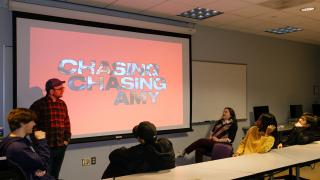
Are big make-or-break assignments and exams a good (or fair) way to assess students? It’s a popular topic in higher education right now, as research suggests traditional grading may have limits for evaluating student learning. High-stakes assessments and letter grades definitely aren’t in any danger of disappearing soon, but an increasing number of faculty are experimenting with alternatives. There are lots of interesting pedagogical strategies to explore, from giving students unlimited chances to redo assignments to doing away with letter grades altogether. However, we hadn’t heard of the idea of “labor-based grading” until we bumped into a post on The Hub blog written by Associate Professor of Composition and Rhetoric Mike MacDonald. He has been using this approach for a few semesters now as part of The Hub Affiliate program. In the spirit of the subject, we didn’t ask him to put a grade on how it’s going, but so far he’s liking what he’s seeing.
So what is labor-based grading? It’s a somewhat nuanced concept with philosophical roots in everything from 19th-century economic theory to modern social justice movements. (For a really deep dive on the subject, check out the work of Asao Inoue.) But the core idea is that instructors should value the actual work students put in over the course of a semester along with their performance. MacDonald was inspired to try it out for a number of reasons, but he says it makes a lot of sense for writing instruction, a discipline where the longstanding philosophy has been to value “the process more than the product.” For MacDonald, labor-based grading gives the instructor better tools to document and give credit for parts of this process that might otherwise remain “invisible.”
In his courses, labor-based grading takes a couple of different forms. One of the most straightforward is the “assignment bank,” where students are given a list of assignments they can complete over the course of the semester. Those assignments won’t be letter-graded themselves, but MacDonald gives students criteria for what constitutes a satisfactory completion of the assignment. If the student finishes more of the assignments, they earn more credit: “So if I have a bank of 13 assignments, and you complete eight, that might be worth a B. If you do nine, that’s a B+,” MacDonald says. In his class, students can also redo assignments as many times as it takes to get full credit.
Another application: In his introductory writing course, MacDonald uses a hybrid approach to take some of the anxiety out of essay writing, the class’s big stress inducer. He still assigns a letter grade to the final essays students turn in. But he breaks the process of getting there into a sequence of smaller component assignments that utilizes some longstanding practices in composition studies. The first exercise, for example, asks students to collect sources and identify quotes they want to use in their essays; the second is an interpretation assignment, where they translate what they think those quotes mean; the third involves organizing that content into themes, which helps form the structure of the essay; and so on. Notably, students get credit for completing each of these assignments, not just the final essay. Moreover, by doing the work in chunks, MacDonald says it removes much of the usual essay-writing anxiety. “So if they’ve done all the work, nobody should be putting together an essay at the last minute. Maybe they’re making final revisions or responding to feedback, but there should be no surprises the night before it’s due.”
So far, MacDonald has only run into a few minor challenges using labor-based grading. Since it’s a little different from traditional grading, students typically have a few questions about how it works, so he has to spend some extra time answering those early in the semester. And Canvas, UM-Dearborn’s learning management software, is built to calculate a student’s course grade based on an accumulation of points, so MacDonald says it can be less apparent to students how they’re doing in his course. Moreso, he’s counting the benefits of labor-based grading. One of his primary goals as an instructor is to simply get students to do as much writing as possible, and having more assignments that seem manageable means his students are doing a lot more writing. That’s good from a practice-makes-perfect standpoint, but he’s also interested in the effect it seems to have on confidence.
“The most vulnerable students often have issues of confidence, especially with writing, and even strong writers can lack confidence,” MacDonald says. “Writing is this thing we always judge and talk about as having such high stakes — like, if you make a grammar mistake on your resume, we assume an employer is going to throw it in the trash. So to have students at the end of the course say, ‘I’ve never done so much writing,’ is huge. For them to see this body of work — just the sheer quantity of it — I think helps build their confidence.”
Inspired by how well these techniques are working, MacDonald says he has hopes to soon teach a 400-level rhetoric course that only uses labor-based grading. The subject: Writing for Games. He’s a huge fan of board games and appreciates all the detailed planning work that goes into creating video games, board games, and even game reviews and analysis. In his view, the subject is a strong fit for labor-based grading because it would spare him the duty of “assessing whether your game is any good,” something he says he’s not qualified to do. But as a rhetorician and game user, he’s comfortable assessing the quality of student’s character creation documents, dialogue trees, or how they communicate their rules to the audience. In other words, what he really wants to see is that you’re putting in the work.
###
Story by Lou Blouin. Interested in learning more about Associate Professor Mike MacDonald’s experiments with labor-based grading? His Hub blog post on the topic is a great read.





